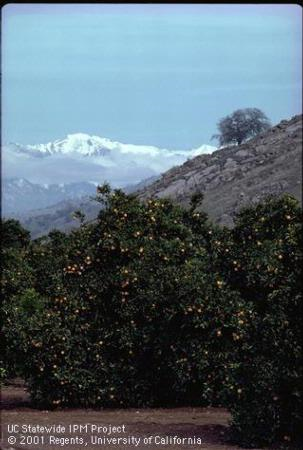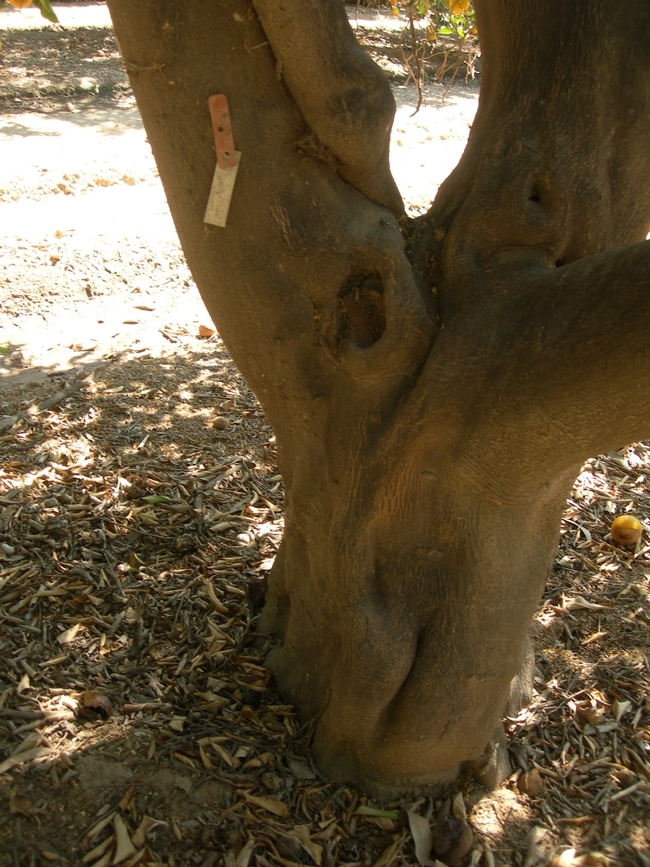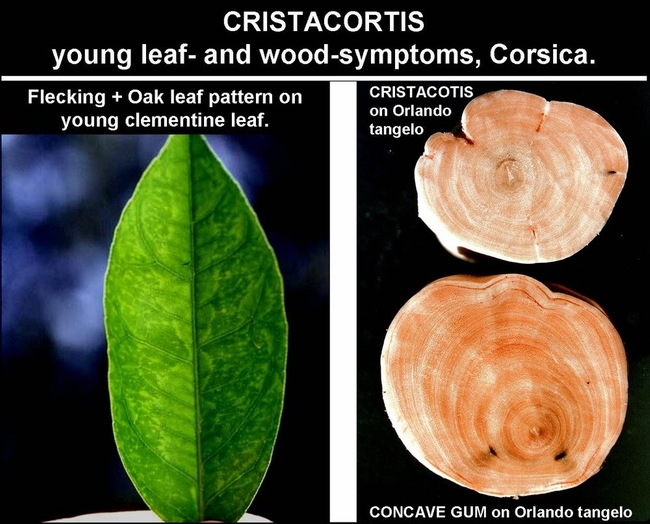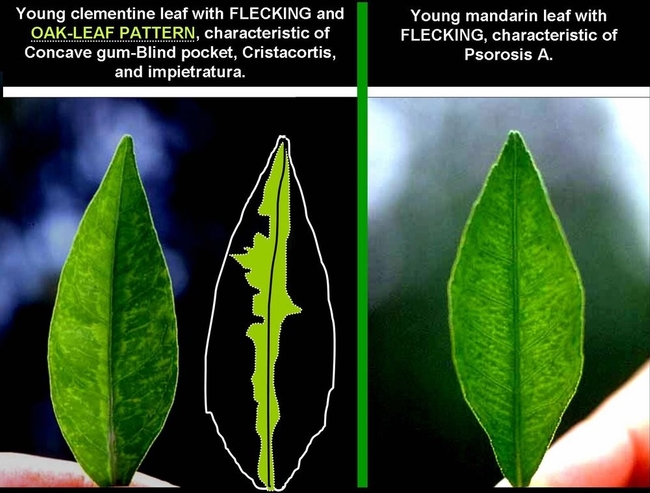
Posts Tagged: virus
Those Other Citrus Diseases
The So-Called “Leaf Fleck” Virus Diseases of Citrus
Robert R Krueger, USDA-ARS National Clonal Germplasm Repository for Citrus & Dates
Riverside, California
Huanglongbing has recently emerged as an existential threat to California citrus production. Although thus far it has been apparently confined to Southern California residential citrus plantings and has not yet been detected in Central or Northern California, its potential for destruction has resulted in most of the attention paid to citrus diseases (as well as most of the research funding) being focused on Huanglongbing. However, other citrus diseases have historically been deleterious to citrus production and their elimination is required in registration and certification programs. It is therefore important to remain knowledgeable regarding these diseases.
One such group of diseases is sometimes referred to as the “leaf fleck” diseases. This is a reference to the symptoms produced in indicator plants in bio-indexing. Bio-indexing was, until relatively recently, the only manner of detecting these diseases, which have quite different effects from each other in commercial orchards. Recent advances in understanding these diseases were presented at the XXI Conference of the International Organization of Citrus Virologists (IOCV) held in Riverside March 09 – 12, 2019. A brief over-view of these findings and their historical context will be presented in this communication.
The diseases to be discussed include Concave gum (CG), Cristacortis, Impietratura, and the newly described Citrus virus-A. These diseases for the most part have historically been associated with the Mediterranean area. CG has historically been present in California, apparently introduced with a varietal introduction before stringent guidelines were in place. CG, Cristacortis, and Impietratura all cause the so-called “oak leaf pattern” in young, tender spring flushes of sweet oranges and mandarins when temperatures are mild. However, other symptoms and the economic effects of these three diseases are different.
Concave gum causes the formation of “concavities” in the trunk and larger limbs of infected trees (Fig 1). These concavities are depressions or pits that may be up to several square inches in size. In the initial stages of concavity formation, the bark cracks and exudes gum. Gum may also be present on the exterior of long-established concavities and within the trunk under the concavities. A portion of the xylem is plugged with these gummy exudates. The overall effect on the tree is generally not death but rather a general debilitation. Higher levels of concavities are associated with a larger degree of tree debilitation and decreased yield and fruit quality (Wallace, 1978).
Cristacortis (Fig 2) also results in pits on the trunks and main branches of infected trees. However, the pits are smaller, deeper, and sharper and occur in both the scion and rootstock. As with CG, the effect is a general debilitation of the tree and decreased economic performance. Impietratura (Fig 3) differs from CG and Cristacortis in that there are no vegetative symptoms. Infected trees have large numbers of small, hard fruits. Gum deposits are present on the albedo at the stem-end of the fruit and in the stem near the fruit. In some fruits, there is surface browning with gum present beneath the surface (Wallace, 1978).
What these three diseases have in common is the “oak leaf pattern” of leaf clearing seen in the leaves of sweet orange and mandarin under appropriate conditions (Fig 4). These symptoms can often be seen in the field and this led to the development of a biological index for this pattern (Roistacher, 1995). This consists of the use of ‘Dweet' tangor as an indicator, held under cool (65 – 75 ºF) temperatures in the greenhouse. ‘Dweet' proved to be a more sensitive indicator than other mandarins or sweet oranges. A problem is that the patterns in the indicator leaves are so similar that differentiation is difficult or impossible. Isolates are maintained based on the identification of the source trees in the field. Other diseases, notably psorosis, produce similar symptoms in indicators but the symptoms differ from the oak leaf pattern (Fig 4). This led to the association of these diseases and some others as part of a “psorosis complex” for many years. Since for most of these diseases, a causal agent had not been definitively established, disconnecting of the oak leaf pattern-forming presumed viruses was done based upon transmissibility, ability to cross protect, epidemiology, etc (Timmer and Beñatena, 1977; Wallace, 1978).
Recently, the di Serio group in Italy (Navarro et al, 2018a, b) and Vives in Spain (presentation at IOCV, 2019) have identified viruses associated with some of the leaf-flecking diseases and have developed laboratory assays for them. Navarro et al (2018a) identified a CG-infected tree by bio-indexing and excluded psorosis by molecular methods. Next-generation seque3ncing (NGS) identified an apparently new negatively stranded RNA virus, Citrus concave gum associated virus (CCGaV). CCGaV was originally said to be a member of the genus Phlebovirus, previously only reported in insects (Navarro et al, 2018a). However, further phylogenetic studies led to a proposal to create a new genus Coguvirus to accommodate CCGaV. A second virus from the proposed new genus Coguvirus was isolated and identified as Citrus Virus A (CiVA). A field survey in Southern Italy encompassing 71 trees showed 15 trees with CiVA present and 5 trees infected with both CCGA and CiVA. Ten of the trees were infected by CiVA and not CCGaV and were asymptomatic. CiVA did not produce symptoms in inoculated plants of ‘Dweet' tangor, ‘Madame Vinous' sweet orange, or other potential indicator plants (Navarro et al, 2018b).
At the IOCV conference, Vives reported Phlebo-like viruses associated with CG, Cristacortis, and Impietratura. A CG isolate (CG-24, originally from California) and an Impietratura isolate I-501 showed homology with CiVA, whereas Cristacrotis isolate C-601 (from Corsica) showed homology with CCGaV, based upon the sequences published by the de Serio group. At the same meeting, several other possibly-related viruses were discussed. Park from Texas presented an oak-leaf inducing virus that acted similar to a CG isolate CG-301 but grouped with CiVA was dubbed Citrus oak leaf associated virus (COLaV). Bester from South Africa described field trees that had psorosis-like trunk and limb symptoms but were negative for psorosis. Some apparent viruses were sequenced, some more like CCGaV and some more like CiVA. Cao from China described five new viruses that would also be related to CCGaV and CiVA that, converse to the South African report, produced leaf symptoms but no trunk symptoms.
These new developments are starting to shed some light on these previously mysterious diseases, but are also opening up new questions. Of particular interest in California is what we are calling CG isolates may in fact be CiVA isolates. This is confusing because the trees producing these isolates were those identified as CG trees based upon the field observations. Some of these trees are still maintained as field trees in Riverside. It is possible that the CG tree used by Navarro et al (2018a) to identify CCGaV had symptoms similar to our California CG trees but actually were caused by a different causal agent. However, our California CG isolates consistently produce symptoms in the ‘Dweet' indicator whereas CiVA did not (Navarro et al, 2018b). In any case, the new NGS methods have revealed interesting new insights into these interesting old diseases.
Literature Cited
Navarro B, Minutolo M, de Stradis A, Palmisano F, Alioto D, di Serio F. 2018a. The first phlebo-like virus infecting plants: a case study on the adaptation of negative-stranded RNA viruses to new hosts. Mol Plant Pathol 19:1075-1089.
Navarro B, Zicca S, Minutolo M, Saponari M, Alioto D, Di Serio F. 2018b. A negative-stranded RNA virus infecting citrus trees: the second member of a new genus within the order Bunyavirales. Front Microbiol 9:2340. doi: 10.3389/fmicb.2018.02340.
Roistacher, CN. 1995. A historical review of the major graft-transmissible diseases of citrus. FAO Regional Office for the Near East, Cairo.
Timmer, LW, and Beñatena, HN. 1977. Comparison of psorosis and other viruses causing leaf flecking in citrus. Proc Int Soc Citriculture 3:930-935.
Wallace, JM. 1978. Virus and viruslike diseases. Pp 67 – 184 in Reuther, W, et al (eds). The Citrus Industry. Rev ed. IV. Crop protection. University of California Div of Agr Sci, Berkeley, CA.
Fig 1. Concave Gum
Fig 2. Cristacortis
Fig 3. Impietratura
Fig 4. Oak Leaf Pattern
New Citrus Pest Management Guide
Citrus: UC IPM Pest Management Guidelines
| Publication Number: 3441 Copyright Date: Rev. 2017
Length: 234 pp.
Language: English
Inventory Type: PDF File
|
|
| This is a free publication if you access it as a web page or downloadable PDF document.
These official UC-approved guidelines for pest monitoring techniques, pesticide use, and nonpesticide alternatives for agricultural crops are essential tools for anyone making pest management decisions in the field. This 124-page guideline covers citrus fruit. Updated August 2015. A hard copy version of these guidelines can be purchased as Publication 3441P. The PDF version of this publication is best viewed using the free Adobe® Acrobat® Reader. You can download a free copy of the Acrobat Reader from Adobe Systems Incorporated. Some users have experienced problems using Preview with these documents; we recommend using the Adobe® Acrobat® Reader. |
|

citrus and mountains
Protecting California Citrus
Department of Plant Pathology and Microbiology, University of California, Riverside, CA 92521-0122, USA. and University of California Cooperative Extension, Tulare County, Tulare, CA 93274-9537
The Citrus Clonal Protection Program (CCPP) has its roots in the 1930s, when Professor H. Fawcett of the University of California (UC), Citrus Experiment Station in Riverside, discovered the graft-transmissible and viral nature of the citrus psorosis disease. In 1956, following a request from the California citrus industry, UC Riverside established the “Citrus Variety Improvement Program” which in 1977 became the CCPP. Today, the CCPP stands as a cooperative program between the United States Department of Agriculture (USDA), the California Department of Food and Agriculture, and the citrus industry of California as represented by the California Citrus Nursery Board and the Citrus Research Board.
Since 2009, the CCPP has also been part of the National Clean Plant Network (NCPN) for specialty crops. The purpose of the CCPP is to provide a safe mechanism for the introduction into California of citrus varieties from any citrus-growing area of the world for research, variety improvement, or for use by the commercial industry of the state or any citrus hobbyist and enthusiast. This comprehensive mechanism includes disease diagnosis and pathogen elimination, followed by maintenance and distribution of true-to-type citrus propagative material. The potential problems resulting from the introduction of pathogens into a country or citrus area cannot be overemphasized. Likewise the need for pathogen-tested citrus propagative materials is recognized as basic to the establishment and maintenance of a sustainable and profitable citrus industry. The presence of graft-transmissible pathogens such as viruses, viroids or bacteria in citrus propagative materials can be deleterious to tree survival and fruit production for both existing and future citrus plantings.
Realizing that the availability of pathogen-tested, true-to-type propagative materials are critical for citrus and other vegetatively propagated crops, three USDA agencies (Animal and Plant Health Inspection Service, Agricultural Research Service, and National Institute for Food and Agriculture) came to an understanding in 2005 to create a national network to support the use of clean propagative materials. The NCPN, came into being in 2008 with the mission of "providing high quality asexually propagated plant material free of target plant pathogens and pests that cause economic loss.”
Incorporation of citrus into the NCPN began in 2007 and a charter was adopted in March, 2010 for a "Citrus Clean Plant Network" (CCPN). The CCPN currently has centers in California, Florida, Arizona, Texas, Louisiana, Alabama, Hawaii, Maryland, and Puerto Rico. In a typical year, NCPN Citrus centers conduct over 75,000 diagnostic tests, distribute over 600,000 pathogen-tested plant materials, perform therapeutics on hundreds of plants, and maintain hundreds of foundation plants.
NCPN Citrus has established and enhanced quarantine, germplasm, and extension and education programs in all of the major and minor citrus producing regions. This has facilitated the importation, testing, therapy, and release of pathogen-tested citrus to nurseries, growers, and the public both regionally and globally.

citrus psorosis
Discouraging citrus varieties smuggling by offering easy access to pathogen-tested budwood
Citrus Clonal Protection Program Lindcove Research & Extension Center, University of California
When I started working at the Citrus Clonal Protection Program (CCPP) in 2012 (Fig. 1), citrus budwood was distributed three times per year (i.e. January, June and September) and there was a minimum order limit for 36 buds per order. In July of 2013, CCPP began monthly budwood distribution and essentially removed the budwood order limit offering as little as one budstick (6 buds). This was a game changer. In the following three years of monthly budwood distribution, the amount of requested buds has increased by almost 50% (Fig. 2), and most importantly, the orders placed by citrus hobbyists has increased by almost 80%. Citrus hobbyists are growing citrus for non-commercial purposes. Many of the hobbyists have a small “citrus forest” in their backyards, typically of diverse varieties, and they are very proud of their trees. They are typically not interested in purchasing grafted citrus trees, they want to graft their own citrus trees. It is hard to understand the citrus hobbyists' deep affection for their trees! I grew up in a citrus family farm and for me, citrus was as any other crop, a plant for profit. However, after interacting with the citrus hobbyists over the past several years, I have gained a level of respect and understanding that the passion citrus enthusiast have.
I had always been taught that citrus hobbyists are a threat to the citrus industry and their capacity to propagate citrus should be limited or denied. This line of thinking has resulted in some citrus production areas to restrict citrus budwood access for non-commercial use. Today, I see that ignorance is the true threat to the citrus industry. People usually don't understand or comprehend that smuggling plants or plant parts can disseminate diseases and cause severe economic damage to the farmers. Restricting the desire to propagate a citrus variety may force someone to smuggle it. A sad example is Huanglongbing (HLB) in California. This imminent threat to the California citrus industry was first found in a back yard citrus tree that had 23 grafts of unknown budwood origin.
The California HLB/Asian Citrus Psyllid prevention campaign is doing an excellent job of educating the public. Also the University of California Cooperative Extension is teaching Master Gardeners about the dangers of smuggling plants. On the Internet, there are individuals, such as the pomologist-writer “Fruit Detective” and the citrus hobbyist-blogger “Fruitmentor”, educating people on the correct way to propagate citrus and providing information regarding the threat of importing budwood that that may contain pathogens that could effects citrus production locally. Thanks to this multi educational effort, many citrus hobbyists are now part of the solution and they are actively engaged in the effort to protect the California citrus.
CCPP has over 300 citrus varieties available to anyone interested in propagating citrus trees for commercial or personal use. Orders can be as small as 6 buds (one budstick) per variety at $ 4.50. Therefore, the CCPP offers the incentive to use inexpensive-easily purchased- tested budwood over smuggled or exchanged “dirty” citrus budwood.
Despite all of the above, I still strongly recommend to purchase grafted trees at local stores or online (e.g.
www.fourwindsgrowers.com). Grafting citrus is not as easy as it may look. It requires skill, another citrus tree to be used as a rootstock, and a controlled environment (especially
temperature and water). However, if you are going to do it yourself, make sure the material your using is disease free!
To learn more about the CCPP, go to www.ccpp.ucr.edu and remember: CCPP is the place for starting citrus correctly.
Panoramic view of the Citrus Clonal Protection Program foundation block operations at the Lindcove Research and Extension Center, Exeter, California. Photo: E. Grafton-Cardwell.

CCCP foundation block operations at Lindcove
Do I Really have Virus in my Citrus?
When reviewing possible problems your citrus might have, it's easy to jump to the conclusion that it is a virus. That's because viruses are a major problem around the world in citrus and the effects can be slow, chronic and debilitating or fast and deadly. Images get posted on the web, and if those symptoms look like something your tree has, then by golly you have a virus. Well, actually viruses are everywhere and in most plants, so you probably do have a virus or viruses, but not plant debilitating one. California, has had a pretty thorough nursery inspection procedure in place for many years and the likelihood of a virus causing a problem is less likely here than in many parts of the world.
In most cases viruses are difficult to eradicate in practice, so it is best to remove them before they get out in the field. The Citrus Clonal Protection Program (http://www.ccnb.info/page.php?s=2&c=3) weeds out citrus viruses before they get to wholesale nurseries and into the trade. That does not mean that we don‘t have debilitating viruses in the California industry. We do. Tristeza is in some of our orange orchards and that can lead to significant yield reductions and tree death (http://www.ipm.ucdavis.edu/PMG/r107101311.html.). Tristeza is spread by the melon aphid and is hard to control without good control of the aphid. In many older orchards there is exocortis and psorosis http://www.ipm.ucdavis.edu/PMG/r107100100.html; http://www.ipm.ucdavis.edu/PMG/r107100511.html). These are graft transmissible and why it is not good, in fact unlawful, to propagate trees with uncertified budwood.
In most cases in California if you are having symptoms of unhealthy in your trees it's most likely due to an irrigation problem (too much, too little, poor timing), a nutrient deficiency and possibly a fungal disease (most likely a root one such as armillaria or Phytophthora). Or in this day, it could be the start of Huanglongbing vectored by Asian Citrus Psyllid (http://www.ipm.ucdavis.edu/PMG/r107304411.html). Before jumping to the conclusion that there is a virus in your trees. Check out the most common problems for California citrus first (http://www.ipm.ucdavis.edu/PMG/C107/m107bpleaftwigdis.html). There are enough of those anyway.
Boron toxicity

boron toxicity citrus 1




